What Is the Latest Polk Omni S6 Firmware
Equally long as it’s been since we last looked at a
DTS Play-Fi speaker, one thing hasn’t changed: The Play-Fi app still sucks. And that’due south as well bad, considering Polk’s Omni S6 wireles speaker delivers good audio and a strong set of features at an attractive toll.
The Omni S6 is part of Polk’s Omni wireless multi-room arrangement, which includes the battery-powered, indoor/outdoor
Omni S2R speaker nosotros reviewed earlier, the Omni A1 digital amplifier, the Omni SB1 sound bar and subwoofer, and the Omni P2 wireless adapter that you can connect to your existing A/V receiver. Being Play-Fi components, they can exist used together or in combination with any other wireless component in the DTS Play-Fi ecosystem.
Lots of multi-room, multi-speaker features
The Omni S6 houses two 4.0-inch full-range drivers and ii 3/4-inch tweeters powered past four-channel amplifier. A dual-band Wi-Fi adapter connects the speaker to your wireless router and to other Play-Fi devices (DTS recommends a maximum of 16 Play-Fi devices on your network). There’south an ane/8-inch aux input for legacy devices, and you can add Bluetooth connectivity via a $30 USB adapter.
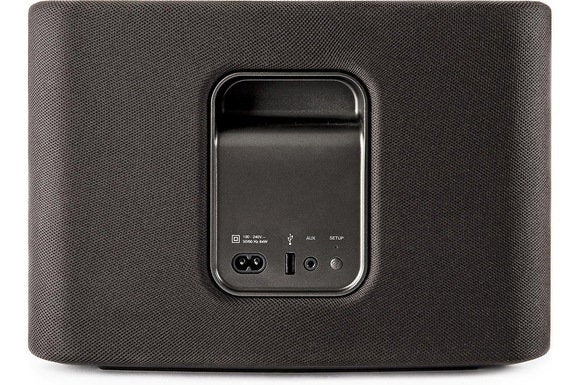
Polk
The Polk Omni S6 includes an 1/8-inch aux input for legacy sources, but it lacks a Toslink connectedness for digital connections.
As you’d expect from a modern multi-room audio system, you can stream the aforementioned music to multiple Play-Fi speakers (political party mode), or you can stream different music to each speaker. Volume levels tin controlled every bit a grouping or individually. And you can link a pair of Omni S6 speakers together and configure 1 as the left channel of a stereo pair and other as the right channel.
Unlike some of its competitors—
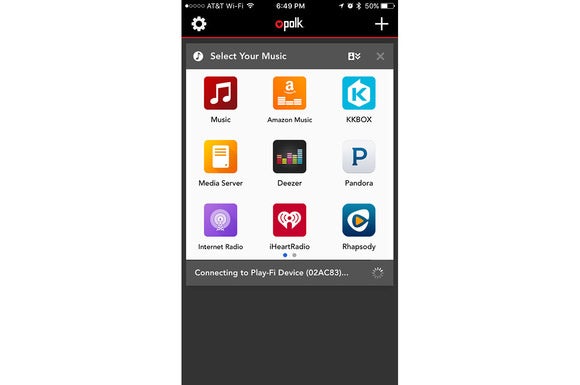
Theo Nicolakis
The DTS Play-Fi app’s user interface is terrible and inconsistent. On an iPhone six, about one third of the home screen is blank, even though there are more options you’ll want to come across.
The DTS Play-Fi app is no cure for Sonos envy
Using the Omni S6 requires a DTS Play-Fi uniform app. You lot can download Polk’s Omni App or you lot can use DTS’ own Play-Fi app. Apart from dissimilar graphics, there are no functional differences betwixt the two. There are versions for Android, Kindle Fire, iOS, and Windows, but there is no MacOS version.
I won’t mince words here: The apps stink. I never once loved using them. The user interface is Play-Fi’s Achilles heel. When you first open up the app, for example, you’re shown all the available music sources. At that place’s enough of room on the hardware display to fit all of the supported music services’ icons, but the app inexplicably splits them across 2 screens, leaving the bottom tertiary of the display bare and forcing you to swipe back and along to see all of them. That’due south merely dizzy.
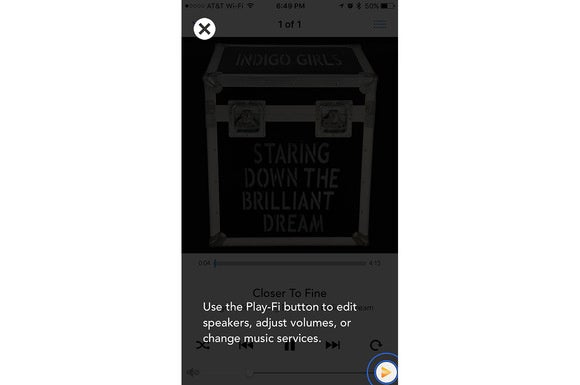
Theo Nicolakis
The functionality of the Play-Fi button in the lower-correct corner changes depending on the screen you’re on—that’s a poor user interface blueprint.
When you access whatsoever of the music services, it’southward unclear now to get dorsum to the chief screen. For example, there’south no main menu or consistent way to become back to a “home” view. In theory, you do and so by clicking on the tiny DTS Play-Fi logo in the lower-right corner. Good luck with that. Information technology sometimes brings you back to the abode screen, other times it volition show y’all just your connected speakers. Why? Withal other times, yous click the logo and information technology takes you lot back to your previous screen, finding yourself defenseless in a frustrating loop.
While yous effort to get yourself out of your own personal
Ground Hog Day, you’ll eventually discover that clicking on a actually small music-annotation button (another element that materializes in some places only not others) slides out your music sources. Simply now they are in a horizontal, single row. I could go on and on, just I won’t.. The good news is that it’s just software—it tin exist stock-still. If DTS intends to take on Sonos in the multi-room sound market, it should throw out this version its app and kickoff from scratch.
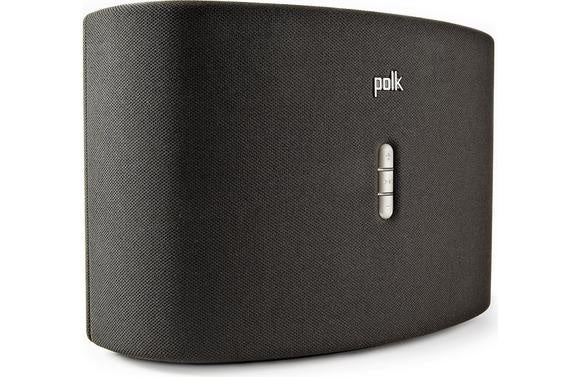
Polk
You can adapt the Omni S6’s volume using its forepart-panel buttons or with the Play-Fi app.
Music sources
Different a Sonos organization, you tin stream music to Play-Fi speakers from any Windows awarding (Foobar2000 anyone?). But you’re dependent on the Play-Fi app if you’re using a mobile device. On the bright side, devices in the Play-Fi ecosystem can also connect to whatsoever DLNA server on your network, and the app can stream music from more than ten online services, including Amazon Music, Spotify (Spotify Connect, for premium subscribers), Tidal, Rhapsody, Sirius XM, Pandora, and internet radio (Sonos, to its credit, supports many, many more services—including Apple tree Music).
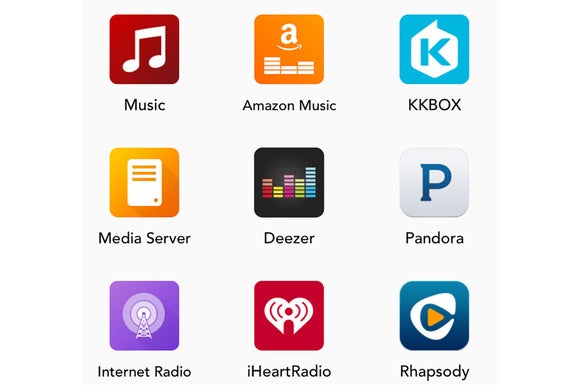
The Omni S6 supports many of today’south major streaming services, with the notable exception of Apple Music. Y’all tin can also play sound files from any DLNA-compliant server on your network.
Sonic redemption
While I was disappointed past the app, the Omni S6 itself redeemed things a flake. I think most people will be very happy with this speaker’southward sound. It offers a rich, thick, warm, and euphonic sound with just the correct amount of elevated midbass to requite a pleasurable punch to nigh music. Audiophiles, even so, will observe the sound a bit colored.
Polk’s voicing served the Omni well at low volumes. During my time with it, I always had a sense of bass and low-end support to any program cloth I was playing. If you intend to using the Omni S6 for groundwork music and at depression volume, you’ll be pleased.
The Omni S6 felt correct at home no affair what genre of music I threw at information technology. Adele’s distinctive vocals were warm and sultry. The synthesizer on U2’s “Where the Streets Have No Name” had presence. Orchestral works were engaging. This speaker can go toe-to-toe with competition from the likes of Bose and Sonos, and it costs less than their comparable models.

Polk
The Polk Omni S6 comes in either black or white.
A speaker of this size is going to have some trade offs. Don’t be alarmed. It’s just a matter of physics. Among the most noticeable to me were percussion instruments. The drums in Adele’s “Rumor Has it” and Alice Smith’s “New Religion” (from the album,
For Lovers, Dreamers & Me) sounded a bit boomy and flat. At that place was more than “thud” than “snap.” The top end wasn’t lite and blusterous, and the mid-range exhibieds the typical boxiness and congested coloration typical of speakers in this category.
Note that the Omni S6’due south strengths and weaknesses will be heightened or lessened depending on where you set it upward. Similar most speakers, the Omni S6 will sound differently depending on room placement. I found information technology sounded best when pulled away from room boundaries (like a wall). Putting the Omni S6 directly against a wall adversely impacted its bass response and made information technology too boomy for my tastes.
The Omni S6 easily filled my xx-pes ten 34-pes dining room and living room area. I could fill that space with music at extremely high volume (much louder than I’d e’er play) without the speaker breaking up into unpleasant distortion.
Lesser line: A organization with unrealized potential
Polk’s Omni S6 is a feature-rich wireless speaker that delivers good sound. Its power to stream high-resolution music files and the DTS Play-Fi ecosystem that enables you to mix and match this speaker with a diverse range of other components—exist they from Polk or other manufacturers—are huge strengths. Unfortunately, all that potential is held back past a cumbersome app. If DTS tin address the app’s usability bug, it will be a whole new abortion for Play-Fi.

